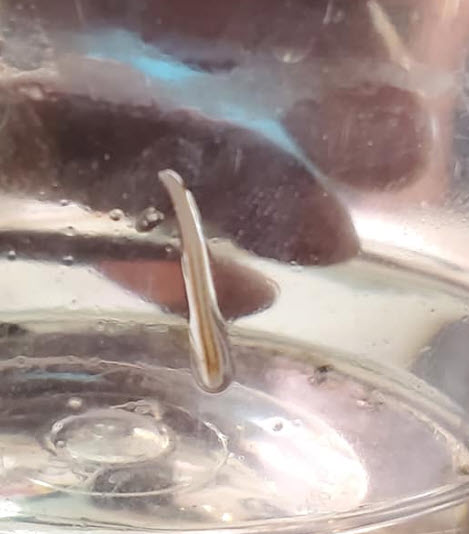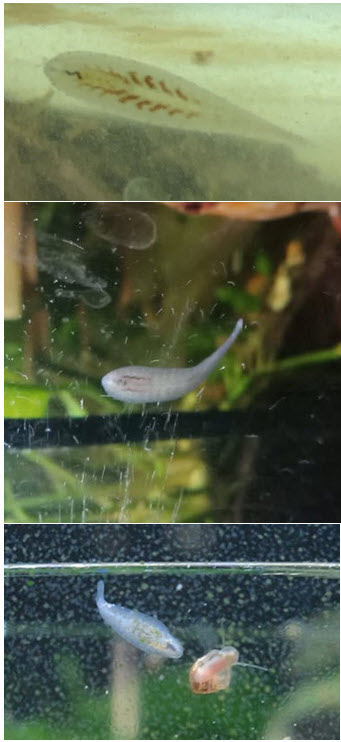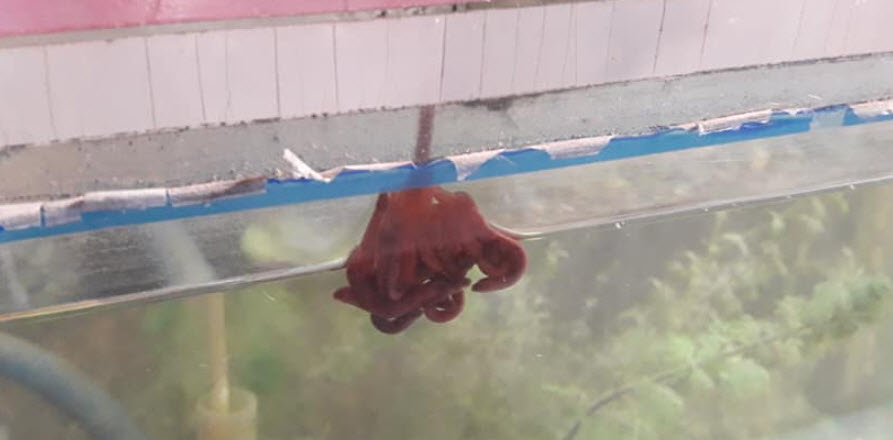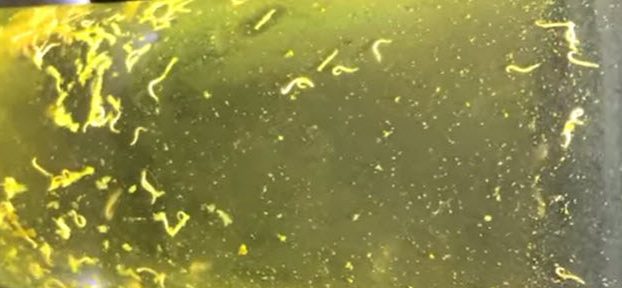
Leeches are interesting little critters sometimes seen in aquariums. They are annelid worms or “tubeworms” closely related to good old earthworms. There are several varieties seen in aquariums. The most common are snail leeches and Asian leeches.
They all have a round body which typically remains motionless and a thinner head that waves about hunting for food. Most move by “inching” along, head attaches, tail moves, tail attaches, head moves etc. Their bodies can typically stretch out quite long and then contract rapidly. These long stretched out bodies look very much like a “worm” and can be white, gray or brown.
Snail leeches
“Snail leeches” are common in aquariums. The typical snail leech attaches to an organism like a snail and drinks its blood. If there are snails in the aquarium and those snails seem to be dying at an alarming rate suspect snail leeches. They can drain a snail dry in a few days.
Most of them look like translucent white or brown (sometimes even green!) worms with a teardrop shape. In an aquarium the thicker half of their bodies remain firmly in place on the glass or substrate while the thinner head portion waves about. There have been videos on social media of the floor of snail aquariums literally covered with small waving snail leeches. Talk about gross! Shrimp eat these denizens.
This is a photo of a typical snail leech. Note the thick body and the narrow tapering head:

Per Aquascaping wiki:
“Snail-leeches can be pretty easily identified by their build – which is drop-shaped. Often, eggs and the digestive tract can be seen in the middle of the body, which makes them easily distinguishable from planarian flatworms. From species to species, snail-leeches vary in color, reddish-brown, green and also creamy-white colors are possible. They can reach a length of up to three centimeters. Mostly they live hidden in the substrate or holding onto stones or plant leaves.
Snail-leeches live predatory off worms and snails, which are unceremoniously sucked dry. These leeches are unsurprisingly VERY unwelcome guests in aquariums containing more special snails like Tylomelania sp. Fortunately, they do not occur in larger groups, but are more likely to pop up as individuals.
The movement of the snail-leech resembles that of a caterpillar. First, the rear end is held on the ground by a suction cup, then the leech pushes its front end forward. Next, the suction cup at the front end attaches to the ground and the tail end follows. This mode of movement is quite different from planarians and other aquatic worms. Furthermore, snail-leeches are skillful swimmers – much unlike planatian flatworms -, moving surprisingly fast through the water in s-shapes. A snail-leech’s body doesn’t feel soft and slimy, but hard and gristly.”

Other species of snail leeches can also present as typical very small brown or black leeches attached to the snails. It takes a good eye to see these tiny critters.
Since snail leeches can suck a snail or shrimp dry it is important to get rid of snail leeches in aquariums with snails or shrimp. Unfortunately that is not easy. All the medications (Fenbendazole and copper) which kill snail leeches also kill snails. Fenbendazole in the water normally doesn’t kill shrimp but kills some types of snails. Sometimes the best course is to remove all snails from the tank to another tank, then treat the infected aquarium for two months. Then put the snails back in.
Asian Leech
Another denizen commonly seen is the common freshwater Asian leech Barbronia weberi. This looks like an earthworm with a slightly slimmer head. Only one half of the body remains motionless while the other half of the body, the head, waves about. Similar to an inchworm, the leech makes steps as it progresses with the help of the suction cups at its front and rear end. This is a picture on such a leech.

The Asian freshwater leech, Barbronia weberi, are typical freshwater leeches that feed on invertebrates (e.g. worms, snails and shrimp) (Govedich et al. 2002, 2003; Neubert and Nesemann 1999; Pavluk et al. 2011; Reed 2001). They are a real problem in shrimp tanks. They have stylets around their mouths which allow them to attach to crustaceans such a shrimp and suck the crustaceans dry.
There are several references on Google which say this leech does not eat shrimp but rather only feeds on small detritus worms. From Aquascaping wiki:
“Even though Barbronia weberi is a predatory leech, small worms and ground-dwelling microorganisms are on its menu. There is no danger for your fish, shrimp and snails.”
Do not believe everything you read in Google. From personal experience I can tell you this leech sucks adult shrimp dry and leaves their carcasses around a shrimp tank. I have had them wipe out the shrimp in a tank.

There have been several hobbyists on social media who have asked how to to eradicate the “dugesia planaria” which is wiping out their shrimp. They have posted a photo or a video of the “planaria”. In all cases the “planaria” was actually a brown leech. It would appear that this leech is not well studied as to its effects in the shrimp aquarium and is very underestimated by the shrimp keeping hobby.

And I can tell you they are very difficult to eradicate. You need to treat the water with fenbendazole for months, which can get expensive.

There are many who look at expanding and contracting brown leeches and mistake them for planaria. Planaria do NOT expand and contract nor do they move even moderately fast. This type of brown leech often swims through the water in a sinuous fluid movement of “S” shapes.
Larger Leeches
There are hundreds of species of leeches of all sizes and colors. Sometimes one will find white leeches of a pretty decent size in the aquarium. These have typically hitch hiked in on a plant and won’t reproduce in the aquarium.

Fish Leeches
Very rarely there will be long thin worm-like fish leeches introduced into the aquarium, typically from live blackworms, bloodworms or tubifex worms. These can multiply and kill fish. This is a very real problem which is only cured with copper or fenbendazole.

“Detritus Worm” Leeches
There are a lot of types of small white “worms” seen in aquarium substrates. These little white worms are called “detritus worms” because they all live in the detritus. Most detritus “worms” are annelid worms (tubeworms). There are two types of annelid worms. The most common type by far looks and moves just like a tiny very thin white earthworm. These are the “detritus worms” commonly found writhing and waving about in the water column.
But rarely some of these worms will be a little thicker than the “normal” detritus worm and move by “inching” over the substrate. The front part of the “worm” will attach itself and pull up the back part. Then the back part will attach itself and push forward the front part of the “worm”. These “worms” are actually leeches (another type of annelid or tubeworm). They feed on other worms and critters in the substrate.
These small leeches can be a problem in shrimp aquariums where they can kill baby shrimp. And sometimes these small leeches are the immature versions of large leeches like the Asian leech, which can eat adult shrimp.

Other Leeches
There is one species of leech that has a very small head on a long and narrow two to three centimeter worm like white body that moves like a planaria, in a slow gliding motion. One has to look for a small head which waves back and forth to identify it. We have been unable to find a clear identity on this leech. But there have been two videos of them posted on social media.
Controlling Leeches
All leeches and snail leeches CAN sometimes be killed by fenbendazole or copper. Dog de-wormer (fenbendazole powder) needs to be administered at a 0.7 grams per 100 gallons level (2 ppm) at one dose every week for three weeks then one dose every month for three months. The leech eggs can take up to 36 days to hatch. Mix the powder into a bottle half filled with water and then vigorously shake the bottle to break up all the lumps.
The fenbendazole is typically purchased as a dog dewormer called Panacur C. This is the dosing needed for leeches:


Obviously if one has an infestation of snail leeches in a snail aquarium the options are limited. Note that the cautions about deaths of snails, shrimp and invertebrates is very dose dependent. Copper and Fenbendazole are often used with no snail deaths because the dosage isn’t high enough. Conversely using a high dosage of fenbendazole can possibly kill shrimp. But copper WILL kill shrimp at any reasonable dosage.
If one has leeches in a tank with only fish and the GH of the tank is greater than 3, then copper becomes the treatment of choice as it is a lot cheaper.
Some of the commercial copper medications which work include Seachem Cupramine, Copper Power, Copper Aide or Copper Safe. If one can’t get these medications one can get copper sulfate as “blue vitriol” in the drain cleaner section of the hardware store. Use the commercial ich medications at a dosage recommended for ich.

Copper has what is called limited selectivity. Copper medication kills invertebrates (ich, costia, velvet, etc.), it has much less of an effect on fish. It is recommended not to use copper in any aquarium which has shrimp, snails, or crayfish.
Copper sulfate, CuSO4, treats leeches at a rate calculated by dividing the water’s alkalinity (KH) by 100 and using that concentration in ppm for the copper sulfate treatment. For example, aquarium water with a KH alkalinity of 80 ppm (dKH of 4.4 or 80/18) would need 0.8 ppm (80/100 x 1 ppm) copper sulfate (CuSO4). If the alkalinity is measured by dKH (typically a number between 1 and 20) the alkalinity needs to be multiplied by 18 before doing the calculation.
This is a very small amount of copper sulfate. In a 100-gallon aquarium one part per million (1 ppm) is 0.38 grams. A typical 100-gallon aquarium with an alkalinity of 80 ppm or a KH of 80 (4.4 dKH) would only need 0.3 grams (0.38 x 0.8 = 0.3 grams) of copper sulfate. A twenty gallon would need only 0.06 grams.
It is typically not recommended to use ANY amount of copper when the water is below 70 KH, or 3 dKH or lower.
It is important to keep up the therapeutic level of the copper for a considerable length of time. Treat once a week for three weeks then once a month for three months. Do a 75% water change before each treatment to remove residual copper and prevent an overdose.
Asian leeches can be controlled by planaria traps. Actually most of the photos of planaria traps on the web show leeches inside them, not planaria. LOL

For more information on all the various pests found in the aquarium click on the following link:
10.13. Pests in the Aquarium
.
Return to Diseases Menu
.
Aquarium Science Website
The chapters shown below or on the right side in maroon lead to close to 400 articles on all aspects of keeping a freshwater aquarium. These articles have NO links to profit making sites and are thus unbiased in their recommendations, unlike all the for-profit sites you will find with Google. Bookmark and browse!
.

S.T says
Thanks for this useful article. I’ve noticed years ago, I have Asian leeches present in all tanks I have (dozen or so), for at least 3-4 years. Some have fish and some don’t. Gave up on trying to eradicate them after seeing just how hard it would be, but it seems after just riding it out, I have never had a problem with them (so far).
They came in with a portion of live blackworms I had ordered. My culture lasted about two years or so, until the leech population exploded in the culture and probably wiped the blackworms out (culture may or may not have crashed independently during that time).
I have no doubts that in such large numbers just like showed in the pictures, these can gang up on shrimps and snails and wipe them dry. However, I do wonder what kind of conditions might lead them to reach such large numbers. They’re at least present in all my tanks like I said, some of them are shrimp/snails only, some of them are quite overfed, but I’ve never had troubles with keeping snails or breeding shrimp.
They take a long time to mature and look like any other detritus worms as babies. Their longer life cycle probably explains why they seem overall not to be as harmful, as they are easier to keep in check. I rarely ever see a fully grown individual, especially in any tank that has vertebrates in it.
I’m thankful for the awareness that these may not be harmless as we might think, but just thought I’d chime in with my own experience of them. In my opinion, if one notices Asian leeches in a tank, one should not panic immediately. Unless the population gets to large numbers of adults, one might not need to eradicate them, and should just keep an eye out for them and pluck out adult sized individuals when possible. In fact, I wouldn’t be surprised if they can serve some useful niche in a tank’s food web in the right conditions. Perhaps outcompeting or predating on other parasites that may be more harmful, aererating substrate, serving as food for vertebrates, being efficient detritivores etc., while being relatively harmless as long as the adult population remains low.
From what I have heard snail leeches can be much more voracious and problematic, even in smaller numbers.
I have indeed noticed since then just how common they are and how often they are mistaken for planaria. Although, due to probably their much slower life cycle or other factors, it seems to me like Asian leeches might be (?) overall less undesirable. Shrimp only tanks are definitely the most at risk of them being a problem, especially if fed generously, perhaps?
Jess Gazon says
Hello, after doing a *lot* of research, I believe the worm you mentioned as a “Detritus leech” is an Aeolosoma worm! I have these in a couple of my snail aquariums and was trying to figure out what they are.
P.S. These actually managed to out-compete my rhabdacoelas and saved the day! Snail babies are safe again 🙂 Thank you so much for all your help!
Dave says
In reply to Jessica …. You are taking about thousands of species. Some will be killed by freezing, some won’t. Medications such as Fenbendazole won’t damage the body structures. And determining which will kill snails would seem to be impossible.
Jessica Gazon says
Would all of the worms/leeches mentioned in the pest articles be killed by freezing? I have a microscope and a LOT of pests popping up lately. A lot of them have contradicting qualities, such as leeches that never swim, or one that sticks its head out of the substrate, has spikes on each cross-section, and likes to stay on the waterline. I was hoping to be able to study them better (it’s a cheap microscope haha) by killing them in a way that won’t damage the body (unsure if fenbendazole/copper/other medications listed have a chance of doing that). A lot of these guys have been driving me crazy trying to figure out which ones are harming my snails and which ones are harmless.
Dave says
In reply to Brad … In general most species of pond leeches do not attack fish. The slime coat on the fish prevents them from attaching.
Brad says
I started a Father Fish resurrection jar, where I collected pond water, leaves and sand and I plan to put that in a planted tank to create a food web. I noticed a leech. It’s about an inch long, dark brown, it swims and see it attached to snails. I can avoid putting the leech in the tank, but what if any eggs on the leaves hatch?
Do they harm(attach to) fish? White cloud mountain minnows
Axel says
Great article, very educational! I found I singular leech in my small walstad tank, regularly seen feasting on small snails in there. Thanks to your article I could now positively identify is as a snail leech. Guess I have a small pet leech now lol. Thank you!
Dave says
In reply to Tony …… No, salt will do nothing to leeches
Tony Russo says
I’ve heard the “The recommended quantity ranges from 1 tablespoon per Gallons to 1 tablespoon per 5 Gallons.” Can treat for some fish diseases. And will kill applied directly on a leach. Will adding salt to the aquarium kill off leaches?
Dave says
In reply to Ben Z …. Fenbendazole is the only treatment which will work in a shrimp tank.
Ben Z says
Dear Dave
May I suggest that you do an article on the biochemistry of how the various treatments work on hydra, annelids, snails and shrimp, etc, just to satisfy the nerds among ur readers? Being from Southeast Asia, I can say (anecdotally, but with great certainty!) that brown leeches are a huge problem in my region whenever one adds plants. I simply never noticed it until I began keeping shrimp recently and realised that they were dying off at absurd rates.
So I did a small “experiment”. I bought a bag of feeder ghost shrimp, split them into two tanks. One was a bare tank with only plants I had grown from cuttings – chances of leeches were minimal. The other tank had recently bought plants. Both tanks were dosed prophylactically with praziquantel.
The shrimp in the second tank died off very quickly. Most of the shrimp in the first lived.
I confirmed visually that there were brown leeches in the tank where all the shrimp died. And they seem very resilient to panacur and the like. I’m looking for cheap alternatives to kill the buggers now…